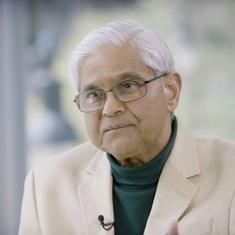If a tennis fan had to wager where Aryna Sabalenka would finally end her strangely dissonant never-reached-a-Grand-Slam-singles-quarterfinal record, the hard courts would be the top choice, followed by French Open’s clay.
Yet, the 23-year-old has upended all stakes by reaching her first Major singles quarter-final and semi-final at Wimbledon, in perhaps one of the bigger and more pleasant surprises at the business end of the Championships. On grass, a surface she has had middling results on in the past, the girl with the tiger tattoo has found a way to balance her ballistic ball-striking with composure and crack the Grand Slam code impressively.
On a women’s quarter-final day where all four matches ended in straight sets, Sabalenka perhaps the toughest test on hand. Playing the versatile and in-form Ons Jabeur, the second seed was almost an underdog. Her grass court and Grand Slam record aside, Sabalenka was up against a player who had bested Major winners Venus Williams, Garbine Muguruza and Iga Swiatek back-to-back with her all-court craft. The Belarusian is a fearsome hitter from the baseline but her big serve and booming groundstrokes can blow hot-and-cold.
It was a fascinating clash of styles that was won 6-4, 6-3 by the controlled power trumping guile, a sight not often seen on grass courts. But then again, Sabalenka in a Major quarter-final was a sight that had not been seen before.
Before this, the 23-year-old had never gone beyond the fourth round in 15 attempts and the highest-ranked woman to not have been in the last eight. In most other cases, 23 would have been an acceptable age to reach this stage but Sabalenka’s consistency on the WTA tour – where she has 10 titles from 15 finals since her breakthrough 2018 – made this an anomaly. She was the best player to not have reached the second week of a Slam at a time when unseeded champions abounded.
Just last month at the French Open, when she was the highest seed remaining and a firm favourite given her form on clay, she sensationally knocked herself in the third round when she imploded against eventual finalist Anastasia Pavlyuchenkova. Then, it had seemed like a real low point, but turns out she made that a stepping stone for genuine growth.
Also read: As Aryna Sabalenka exits another Grand Slam early, what is holding her back?
So, what changed? As simplistic as it sounds, it was all about finding balance, in her head and in her groundstrokes. She worked with a psychologist, began enjoying playing and built sustained rhythm on a surface that rewards attacking players.
The big differential in the match was Sabalenka’s winner to unforced errors ratio, which has almost always been the cause of her downfall. In the quarter-final, she hit 26 winners to 20 errors, against Jabeur’s 22 winners and 11 unforced errors. Crucially, these winners came on big points.
The marathon tenth game of the first set was the best illustration: After one breakpoint on Sabalenka’s serve in the first game, both players tight-fisted on serve for nine games. Till Jabeur, serving to stay in the set, was put under the pump. She saved four set points in a game that had seven deuces and was almost eight minutes long. But Sabalenka kept attacking and converted her fifth with a crosscourt forehand. She then came from 0-40 down in the first game of the second set, broke Jabeur and was broken back. But she didn’t let her rhythm get broken, playing her shots with a focus that finally overpowered the Tunisian’s shots, saving a breakpoint while serving for the match.
In most other matches, these are the games and points that she has floundered on. Overpressing on breakpoint, losing focus after a string of poor serves, getting pushed to a decider. But in her first Grand Slam quarter-final, she played with a nervelessness that belied her career graph. She saved six of seven breakpoints, didn’t look overawed or let her body language slump and relentlessly focussed on getting the ball back.
After the match, the second seed was brutally honest about her struggles. “I was struggling on the Grand Slams with all emotions going through. After every Slam, I was so disappointed about myself that I can’t handle this pressure. I actually thought that I will never make it to the second week. We worked a lot with my psychologist and with my coach,” she was quoted as saying by Wimbledon’s official site.
Physically, Sabalenka has all the elements of a genuinely solid game and the added advantage of pulverising the tennis ball like few others. Now, she seems to have gotten that fierce element in her mentality too.
If Sabalenka has solved the Grand Slam riddle, then it should ring alarm bells for any opponents. Next up is Karolina Pliskova, a first-time semi-finalist at Wimbledon who has far too long been one of the more consistent players to never have won a Major. The former world No 1 has all the weapons Sabalenka does, with more experience, a more reliable serve but similar nerves. If it all comes down to the mental game, the battle of booming hitters will give Sabalenka’s newfound mentality its biggest challenge.










